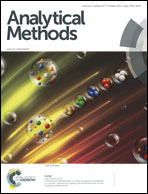A novel alternating least-squares method based on fixed region scanning evolving factor analysis (FRSEFA) and its application in process monitoring
Abstract
A new method called fixed region scanning evolving factor analysis (FRSEFA) is proposed based on fixed-size moving window evolving factor analysis (FSMWEFA). In FRSEFA, a base set matrix Xbs that is a submatrix of the entire spectra data matrix X, corresponding to a special region in the time direction, is selected. Then, the base set Xbs combines a moving window xi containing only one time point to construct a submatrix Xt,i. A series of eigenvalues are obtained to accurately determine the starting time or ending point because the moving window contains only one time point, so that the problem of time shift in FSMWEFA can be solved. The combination of FRSEFA and alternating least squares (ALS) is utilized to determine the precise time of the transformation of components during the reaction and to obtain the profiles of concentration and spectrum of the components of interest in the mixture. Two real experimental data were studied by the developed algorithm. The results showed that the precise time of transformation could be obtained and spectrum and concentration profiles were also estimated, providing more useful information for reaction processes.


 Please wait while we load your content...
Please wait while we load your content...